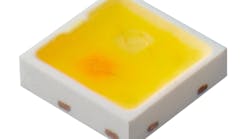Typically, a white LED contains a blue- or near-UV emitting chip coated with a phosphor material; the rare-earth phosphor absorbs light from the LED and re-emits it at a different (longer) wavelength. However, more than half of the photons produced by the phosphor are diverted back toward the LED chip where much of the light is lost due to absorption. This reduces the white LED’s overall light output.
The group led by Nadarajah Narendran, director of research at the LRC, has developed a method to extract the backscattered photons by moving the phosphor away from the semiconductor and shaping the LED lens geometry. When combined, these changes allow the photons that would typically be absorbed inside the LED to escape as visible light. The new technology is patent pending.
“We have developed a technology based on scattered photon extraction (SPE) that will speed up the progress of solid-state lighting and help secure our nation’s energy future,” said Narendran. “The new technology dramatically increases light output and efficacy of white LEDs, and could play a fundamental role in the evolution of white LEDs for lighting in homes and offices.”
Compared to commercial white LEDs, prototypes of the new SPE LED technology produced 30-60 percent more light output and luminous efficacy. This means more visible light is produced without increasing energy consumption.
Industry has set a target for white LEDs to reach 150 lm/W by the year 2012, while the new SPE LEDs, under certain operating conditions, are able to achieve more than 80 lm/W.
“As LED components improve in efficiency, SPE will further multiply those improvements and help catapult the industry toward its goal,” said Narendran. “The possibility of solid-state lighting replacing traditional incandescent and fluorescent lamps looks promising.”
Narendran's research was funded by the U.S. Department of Energy’s Building Technologies Program and the National Energy Technology Laboratory through its competitive research and development program (cooperative agreement no. DE-FC26-01NT41203), and is a collaborative effort with the University of California , Santa Barbara.
The SPE research is published online in the journal physica status solidi (a), published by John Wiley & Sons, and will be published in an upcoming print edition of the journal.




